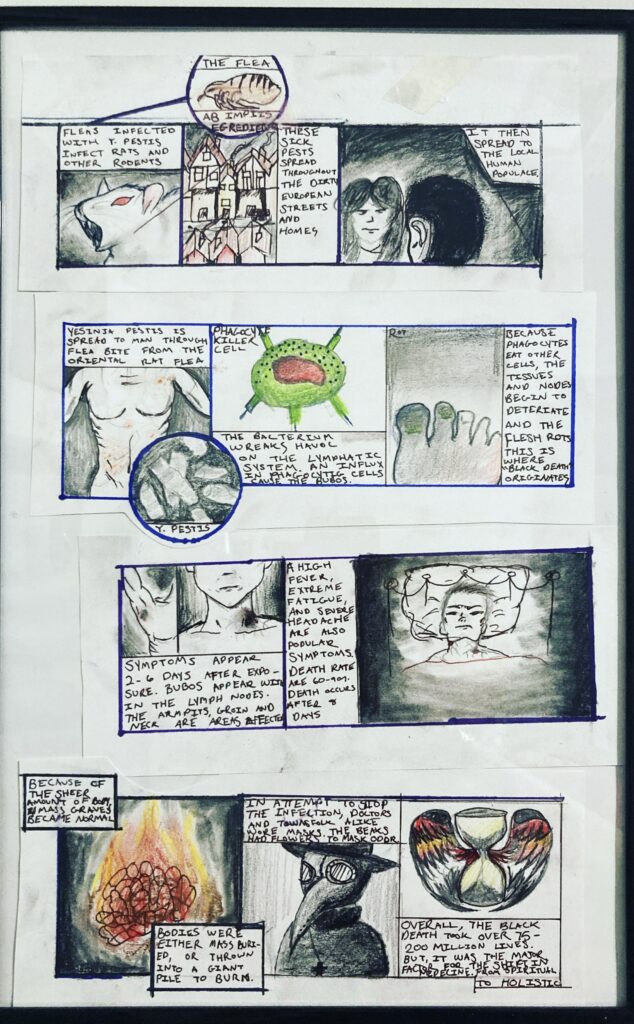The steam project I tried to do was a comic strip detailing the spread of Yesinia Pestis on a cellular and societal view. The bubonic plague or “Black Death” was an incredible pandemic that spread across Europe, north Africa, and Asia through 1346 – 1353. Although it was a relatively short amount of time, this biological weapon killed at most 200 million people and took out 30 – 60% of the European population. The infection started in Asia and moved its way west through the trade routes. Yersinia Pestis the bacterium that’s behind the bubonic plague, was found in Oriental Rat Fleas. These fleas attached themselves onto rats, which were actually surprisingly resistant to the plague. The rats carried the killer with them all the way to North Africa and Europe, where it struck hard. At the time, across Europe had kings, and when there’s kinds, there’s peasants. These peasants were dirt poor and unclean. Most excrement was simply thrown into the street for disposal. They were packed into tiny houses which were packed together. This dirty and stuffy environment meant rats were thriving. And so, the plague took hold. Y. Pestis can’t be passed human to human easily, more often, humans will get bitten by the rat carried fleas, and the infection will set in. Within 2-6 days of exposure symptoms will appear. These range from a raging headache, extremely high fevers, and of course black pus -filled buboes appearing in the groin, on the neck, and in armpits. The bacterium attacks the lymph nodes and causes an influx in Phagocytes. Specifically, phagocytes killer cells, which are responsible for eating and engulfing other alive cells. This led to a breakdown of the lymph nodes, and a complete shutdown of the immune system. The lymph nodes fill with pus, blood, and dead flesh to form the dreaded black bubo. Because this is dead flesh, it often smelled awful. “A pocket full of posy….” The lyric from “Ring around the rosy” originated from people stuffing poppy flowers other strongly smelling flora in their shirts and trousers in attempt to mask the odor of death. Of course, “Ring around the rosy…” refers to the appearance of the buboes. The black ring is rotting flesh, and the rosy being the blood- and pus-filled lymph node. The death rate was extremely high, between 60-90%, and it was known as being a very painful and bitter end. “Ashes, Ashes we all fall down.” The way to get rid of the affected bodies was to burn them to ash. Of course, “…we all fall down.” Many people saw the plague as the end of the world and assumed that everyone was eventually going to succumb to its deadly reign over society.


Fox Elmore did his project on the bubonic plague and its effects on the Lymphatic System. He demonstrated his understanding by creating a comic strip – which is impressive! Not only did Fox include the necessary information needed to demonstrate his understanding of his decided STEAM topic, but he also made it enjoyable to read. He included the rats that carried the bacteria in their fleas, an image of the bacteria, and the side effects of infection.
Accompanying the comic strip, which highlights the infectious bacteria that caused millions of people to lose their lives, describes the pandemic. Fox includes a background of the plague, mentioning that this “biological weapon” (Elmore) killed nearly 30-60% of the European population. He mentions that the bacteria behind the bubonic plague, called Yersinia Pestis, was found in Oriental Rat Fleas. The disease spread quickly due to peasants’ filthy living conditions and close living quarters during this time period. Fox represents his understanding of the bubonic plague and its effects on the lymphatic system as he describes the breakdown of the lymph nodes due to this bacteria. He mentioned that the bacteria cause an influx in the phagocytes, which leads to the breakdown of lymph nodes, then the “complete shut down” (Elmore) of the immune system. Fox describes the condition of the lymph nodes, mentioning that they become filled with pus and blood. He lastly mentions that to the drastic effects of this plague, many people thought it would cause the world to end.